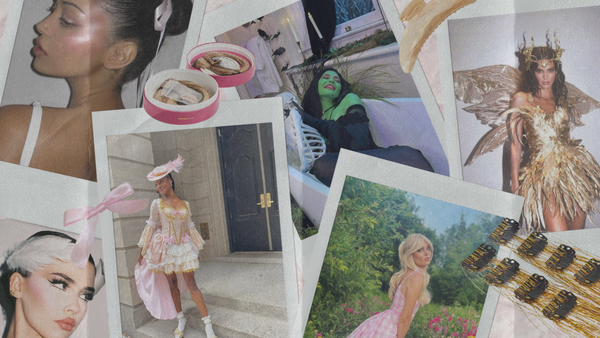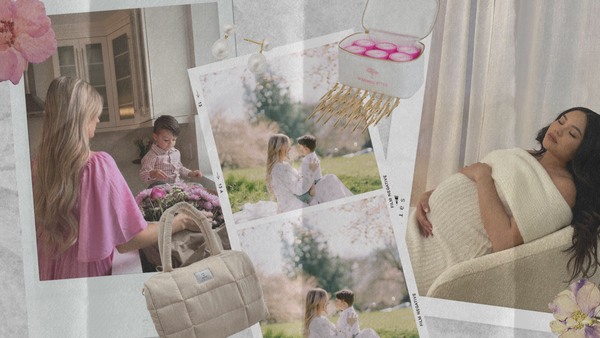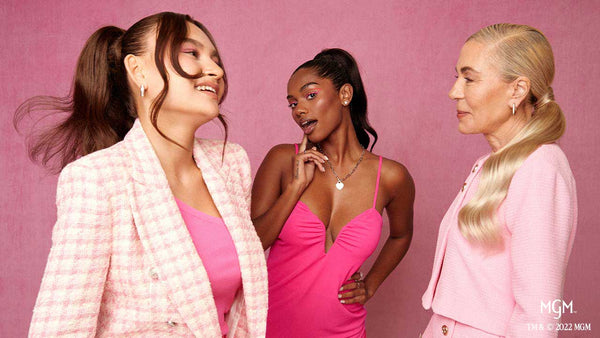Your skincare routine is just as unique as you are, and building a skincare routine should start with exactly that question: What should my skincare routine be?
If you’re new to the skincare game or want to switch up your routine to address specific issues, we first say, congratulations. Any step towards bettering your health is a good one, but with an industry worth more than $100 billion globally, it’s easy to become overwhelmed with hundreds of product options.

When looking at how to start a skincare routine, it’s important to bust a few skincare product myths:
Pricier is better: Some of the best skincare products can be found on the shelves of your local drug store, don’t assume a hefty price tag means a more luxurious product every time.
It works for my bestie/sister/co-worker/favorite influencer, it’ll work for me: Recommendations are great, but everyone’s skin type is unique, a lot of skincare routine building will involve trial and error.
The more, the merrier: You don’t need a vanity full of products or a 21-step skincare routine because you saw it on Instagram, just like the statement above, each skincare routine is different. But if yours does happen to be 21 steps, we want a tutorial.
Buzzwords like “natural” and “clean” mean fully green: Unfortunately not true. Brands take some liberty in what natural beauty or skincare can entail, and not all products are fully reviewed or federally tested. This goes for other buzzwords like “anti-aging” or hot-topic ingredients such as Moroccan oil or Hyaluronic acid. Always – we repeat – always read the labels and ingredient list, especially with products you haven’t used before.
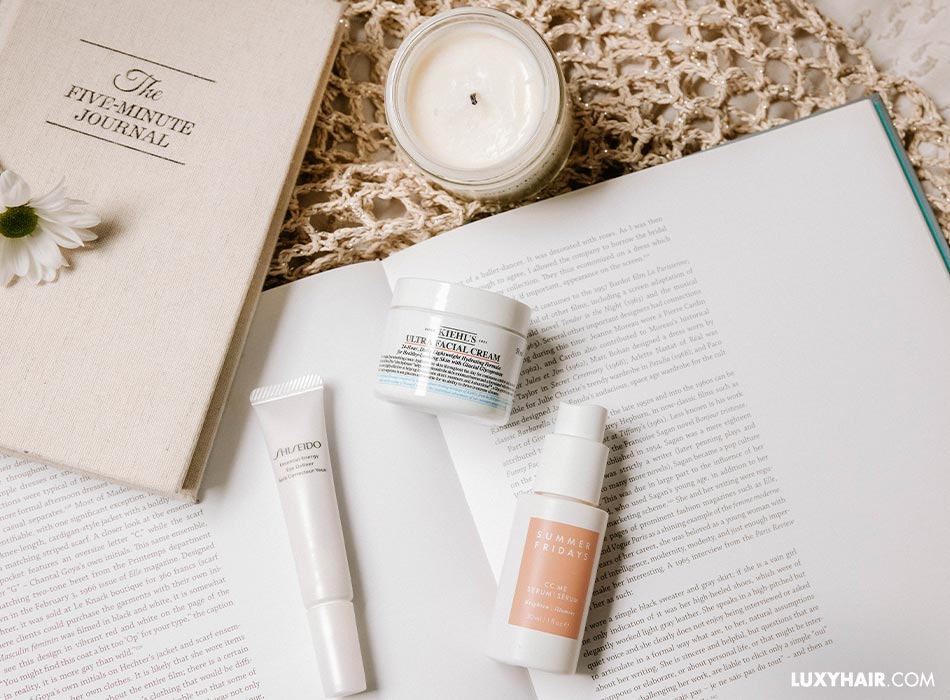
Determining your skin type
Now that those are out of the way, let’s get into how to build a skincare routine. First, determine your skin type. What is your skin like after a shower with no product or no makeup?
If you have pre-existing skin issues such as rosacea, acne or eczema you may have more sensitive skin. If you notice shine, or it gets a little greasy after a shower and no product, you have oily skin. If it gets dry or flaky quickly, you have dry skin. If you have shine or grease on your T-Zone (forehead and nose) but not anywhere else, you may have combination skin.
If you’re one of the lucky ones without any of the above, congrats, you have normal skin. To note, you can have skin conditions (acne, rosacea etc.) and have dry, oily, or combination skin.
Knowing your skin type is just like knowing your hair type. When you can identify what you need most, you’ll save yourself time and money trying to guess and address your problems. You don’t need to go to a dermatologist to determine your skin type, but if you have existing skin conditions, sensitivity, or are using a prescription topical, it never hurts to make an appointment.
The basic skincare routine essentials
The beauty of a skincare routine is there are staple must-haves and several options. It’s the options where most people get intimidated or confused. But if you want to cut through the fluff, ensure you have these three essential steps:
- Cleanse
- Moisturize
- Protect
If you have a skin condition that requires prescription topical treatments, add that after cleanse and before moisturizing.
Step 1: Cleanse
Cleansing can be done once or twice a day in the morning and before bed. Double cleansing is for those who wear more makeup or use more sunscreen during the day and really want to get every little bit of product off. Double cleansing usually requires using an oil-based cleanser first to remove as much makeup or product as possible, followed by a water-based or micellar cleanser to remove any excess. Double cleansing is an optional step.
How to choose the right cleanser for your skin type:
If you have oily skin, gels and gentle foaming cleansers work well to help balance your body’s natural oils. Be sure to look for products that are free of sulfates as you don’t want the cleanser to strip too much of your natural oils. This could lead to your skin overproducing oil to make up for it, resulting in an endless cycle.
For those with dry or sensitive skin, creamier cleansers are the best choice. There are also many cleansers that feature crystals or beads that usually offer some exfoliation. These types of cleansers work for multiple skin types but depend on what you want to achieve for your skin. Sometimes, this physical exfoliation may be too harsh for sensitive skin, so always check the ingredients and what problems they target.

Step 2: Moisturize
Moisturizing should be done every single day. Moisturizing boosts skin hydration and ensures the stratum corneum, the outer layer of our skin, is working properly. When the stratum corneum is hydrated, it protects the other layers of skin from irritation and inflammation, also helping the deeper layers of skin stay hydrated.
How to find the right moisturizer for your skin type:
No matter your skin type (hey, oily skin gals we’re talking to you) moisturizing is a step in your skincare routine you shouldn’t skip. If your skin is not well-moisturized it can lead to irritation, breakouts, and even acne – the opposite of glowing, healthy, hydrated skin goals. This little tip also goes for those with dry scalp, too. The key is to find a moisturizer with the ingredients that work with your skin type.
Almost all moisturizers contain humectant ingredients and occlusives. Humectants soak up and retain water from the air and occlusives hold water in. If you have dry skin, look for moisturizers with ingredients such as hyaluronic acid, which is a strong humectant. Thicker moisturizers or creams also work better for those with dry skin.
For oily or acne-prone skin, be on the look out for oil-free moisturizers and lotion formulas that are lighter. Gel moisturizers also work well for oily skin.
How to apply moisturizer:
As moisturizer is a key step to every skincare routine, you should know how and when to apply it. After you rinse off your cleanser, apply your moisturizer while the skin is still damp. The skin absorbs humectant ingredients better while still a little wet and this will help soak up the product, sinking deep into the skin.
If you’re just starting to build your skincare routine or are looking to try a new product test it out first. Just like you’d swatch a new lipstick or eyeliner, test the moisturizer. This can be done two ways; the first, test a small amount on the inside of your arm. This area of the body has a thin layer of skin and is similar to the face. Watch for any reactions or irritations. The second way is to test a small amount of product on the base of your jawline, it’s in a discreet place should any irritation occur. Try a product out with your regular skincare routine for about a week.
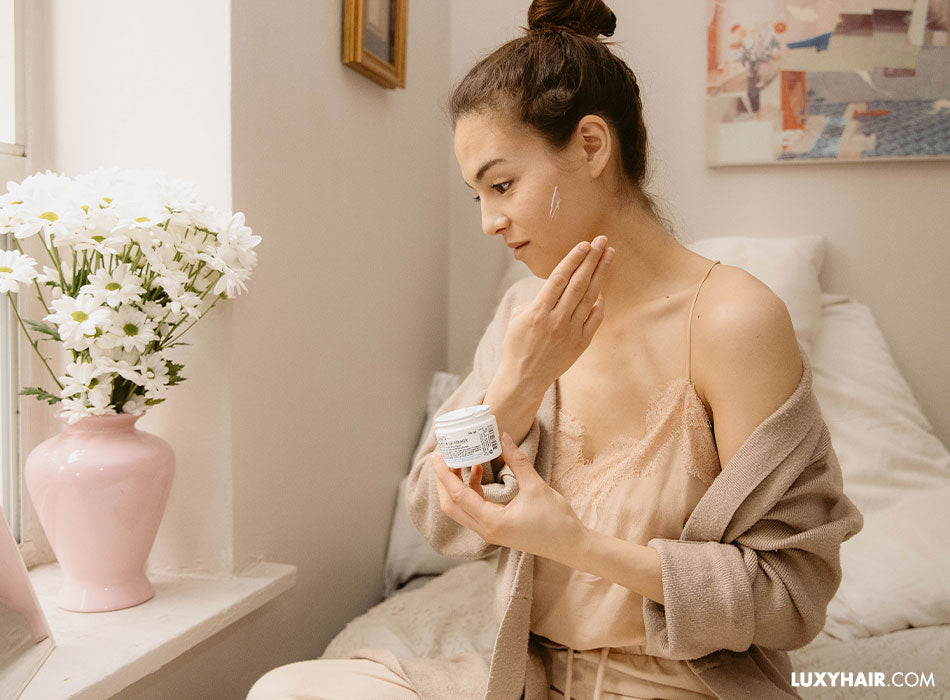
Step 3: Protection
Finally, protection. This means an SPF product to protect your skin from UV rays – crucial in warmer, summer months, but also essential in fall and winter. While we have your attention, it’s also essential to protect your hair from harmful UV rays too. There are several moisturizers now that do double duty and come with SPF, but make sure it’s enough. Dermatologists recommend an SPF of at least 30 for the face. Sunscreen not only protects from the obvious problems such as sunburn but goes back to strengthening the first layer of skin, the stratum corneum. Protecting your face from UV rays will help prevent further problems such as dryness, irritation, hyperpigmentation and yes, wrinkles.
The skincare routine optional add-ons
As we’ve said before, loving the skin you’re in means building a skincare routine that’s totally unique to you and your needs. While the three essentials are recommended, they may not be enough for what your skin needs, so here are a few popular optional products or steps to consider when asking what should my skincare routine be?
1. Eye treatments
Be it a serum, cream, mask or roll-on, eye treatments can be a whole other skin routine onto themselves.
This is at the top of our optional skincare routine list, because let’s face it, the eyes give away so much. The most common concerns with eyes include dark circles, puffiness and fine lines. Most eye treatments are multi-functional tackling one or two (sometimes all) in one product. As the skin around our eyes is even more sensitive, it’s essential to read the ingredients and do the jaw-line patch test.
For dark circles and fine lines, masks and serums work really well. Be sure to read instructions carefully, as many eye treatments have different usage recommendations based on their ingredients (twice a day, once a week, 2-3 times a week, etc.)
Roll-ons and masks, especially those with cooling features or ingredients are great to help reduce puffiness and smooth lines. Not to mention they offer a soothing and relaxing sensation.
Apply your eye cream or serum after moisturizing and before sunscreen. Be sure to let the products breathe in between applications, meaning don’t apply each product right after each other, give it a few minutes after application.

2. Toner
Toner has seen a resurgence in the skincare routine game over recent years. In the past, it was mostly used for oily and acne-prone skin, containing alcohol to really scrub out clogged pores and pimples. Now, however most toners do not contain alcohol and are made to address the same type of skin concerns as cleansers and moisturizers.
That being said, toner is not essential when you are looking at how to start a skincare routine. Toner is almost like makeup primer, it delivers a quick hit of hydration to your skin, while cleaning or removing dead skin cells. Essentially, toner preps the skin for the hydration boost your moisturizer will apply.
It’s best to apply toner soon after cleansing. It can be done by patting the product into the skin with your fingers or hands, or you can apply toner onto a cotton pad and dab or gently wipe it across the face. Either way, toner can be applied both in the morning and nightly, especially after cleansing makeup or oil at the end of the day.
3. Face spray or mist
Makeup lovers know the benefits of a good setting spray, but thanks to the advancements in skincare products these sprays have evolved. Using a face spray or mist isn’t just reserved for keeping your make up intact, there are several options now that you can use to hydrate and tone the skin throughout the day. Working similarly to a toner, a facial spray can give your skin a boost in complexion, reduce shine, give you a kick of hydration, or simply cool you down. This is a nice to have skincare step and can really fit in whenever you need a little refresh. The convenience of a spray or mist is its portability. Pack one in your purse or gym bag and give your skin a little love during your day.
4. Face masks
There are a ton of options when it comes to face masks; sheets, peels, creams – we can go on for a while. Face masks are best reserved for once or twice a week depending on your skin type and the type of mask. It’s hard to rank one type of face mask over another (it’s like picking your favourite child) as they all work to achieve different things, and let’s face it our skin needs different treatments throughout the year. Face masks, like hair masks typically offer extra exfoliation, moisturizing or targeted treatments. We suggest picking a face mask the same way you pick your moisturizer; target your biggest concerns and experiment! Sheet masks in particular come in a range of prices to suit any budget; this is a good way to try out a few different ones to see which ones best work with your skin.

5. Facial tools
Facial tools are considered nice to haves and range from drug store prices to uber luxurious, spa-level coin. Tools such as jade rollers, gua sha, microcurrent wands, etc. help to work in products, specifically serums and oils. Not to mention, they add some TLC to your skincare routine when you’ve got a bit more time. For micro needling or microcurrent devices, do your research. These tools are on the more expensive end and target fine lines, discoloration and other conditions that may not be necessary for skincare beginners. We recommend starting with a facial roller to help work product in. There are also a ton of great tutorials online that will demonstrate how to increase circulation and blood flow that will reduce inflammation and puffiness around the eyes, neck and face.
Building a skincare routine shouldn’t be intimidating and comes down to what your skin really needs, and not just which products look or smell the best. Remember that your skincare routine is your own and you may not find all the best products for yourself right away. What’s your biggest skin problem today? Choose your essentials based on this question and you’ll go from skincare beginner to skincare guru all while helping getting the best skin possible.
Written by: Rosalyn Solomon


